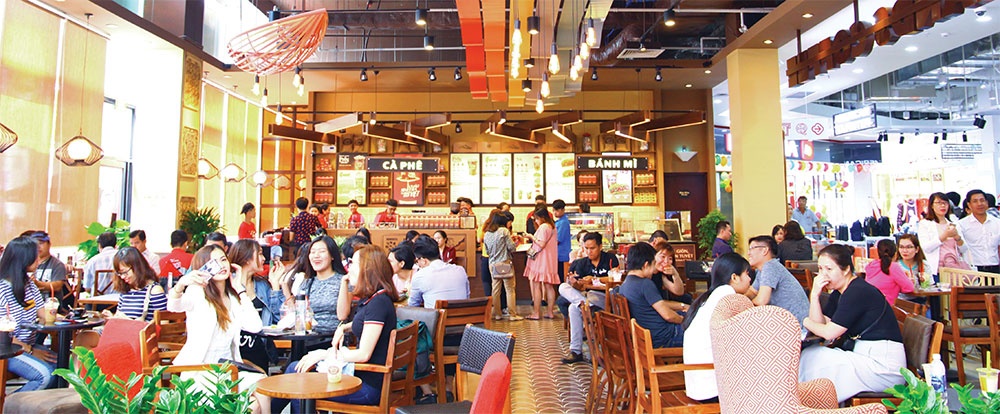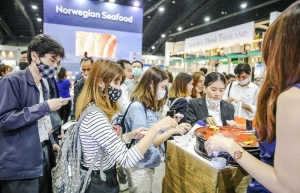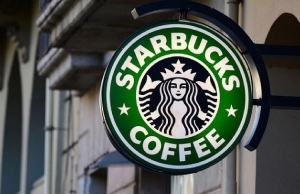F&B groups snapping up new stores in bid for victory
The rising cost of living around the world has made consumers more cautious in their spending habits, and Vietnamese consumers are no exception.
 |
| Cafes of all shapes and sizes in Vietnam are booming again, and some chains want to capitalise with new offerings and locations, photo Le Toan |
According to the 2023 PwC Consumer Insights Survey in Vietnam released last week, 62 per cent of consumers are reducing consumption of non-essential items, which is lower than the global average of 69 per cent. The spending cuts hit non-essential items the most, including luxury goods with 54 per cent, followed by travel with 42 per cent and electronics with 38 per cent.
Only 18 per cent of Vietnamese consumers plan to cut spending on groceries and food, lower than the global average of 24 per cent.
Statistics from payment platform Payoo also indicated that food and beverage (F&B) revenue in Q1 held positive growth. The catering business of mid-range restaurants and fast-food chains with a spending level of $6.50-13 has grown by 30 per cent compared to the previous quarter. Particularly, the group of milk tea and coffee products with an average unit price of $1.50-3 increased slightly by nearly 5 per cent compared to the previous quarter.
High-end restaurants with a spending level of at least $43 per person for each meal are steadily growing, even attracting more customers, although the average value of each order increased by 7 per cent compared to Q4 last year.
“Economic challenges may affect most consumers, but not all. There are always those who are immune to the crisis because their wealth and spending power are huge. That is the reason why although many common items have decreased in purchasing power, some spending on goods and services has remained stable, and even increased slightly,” a representative of Payoo shared.
At the end of March, Golden Gate, a restaurant chain with nearly 400 stores throughout the country and serving about 18 million customers per year, released its financial statement for 2022, reporting spectacular growth in both revenues and profit.
The company’s net revenues reached $296.85 million, equivalent to more than $826 per day, double on-year. Of this, revenues from selling food and drinks were $296.4 million and gross profit was $187 million, up 124 per cent, the highest in the past eight years.
Pizza 4P’s, after two consecutive years of losses, reported a profit of nearly $3.6 million last year. Pizza 4P’s currently has a total of 30 branches, including 14 in Ho Chi Minh City and 10 in Hanoi.
Phuc Long, a coffee and beverage chain belonging to Masan Group’s retail ecosystem, is currently leading in terms of number of points of sale in the F&B segment in Vietnam, with 132 stores and more than 1,000 kiosks. It also recorded positive business results with $68 million in revenues and $8.4 million in pre-tax profit in 2022.
Masan Group forecasts that Phuc Long’s net revenue in 2023 could reach $108-130 million, a solid growth of as much as 90 per cent against last year, mainly thanks to the successful opening of around 90 new stores.
In addition, Phuc Long will also begin loyalty integration into Masan’s WIN membership initiative, providing customers with more benefits. It is also considering renewing its menu in the second half of this year to give consumers more interesting choices.
Although its specific revenues and profit have not been disclosed, the steady growth of the sector is also the main reason why Starbucks plans to increase the number of stores from 87 to 100 this year, and continues to look for business opportunities to extend its footprint in new locations outside its existing cities.
“Starbucks expects to open its 100th store in Vietnam this year, but that doesn’t mean it will stop there,” said Patricia Marques, general manager of Starbucks Vietnam.
According to a report published by iPOS.vn in early 2023, Vietnam’s F&B sector possesses great growth potential, with a market value forecasted to reach nearly $43 billion by 2026. The report also indicates that the revenue of the F&B market in Vietnam recovered close to pre-pandemic levels at the end of last year, reaching more than $14 billion.
“The number of guests returning to eating out has increased greatly, making the spending rate also increase. Vietnamese consider food as a cultural feature, so eating out is also a major connection,” said Vu Thanh Hung, general director of iPOS.vn.
By the end of 2022, Vietnam had nearly 338,600 restaurants and cafés. The number of F&B restaurants in Vietnam is set to increase gradually, with a growth rate of about 2 per cent annually.
 | World opening eyes to exciting Vietnamese offerings in F&B Vietnamese food and beverage groups are increasingly making their presence felt in numerous countries worldwide thanks to the remarkable quality improvement of goods, with a huge trade fair this week set to put even more of these goods on show. |
 | F&B mainstays taking digital direction Vietnam’s food and beverage sector is increasing cooperation with cashless payment solution providers to offer better customer service and accelerate such payments across the country. |
 | Foreign groups locking eyes on F&B Vietnam’s food and beverage sector is expected to see robust mergers and acquisitions amid the tough economic context. |
What the stars mean:
★ Poor ★ ★ Promising ★★★ Good ★★★★ Very good ★★★★★ Exceptional
Related Contents
Latest News
More News
- First members of Danang International Finance Centre revealed (December 22, 2025 | 17:39)
- Human-centred governance seen as key to AI development (December 19, 2025 | 18:19)
- Top 10 notable events of Vietnam’s industry and trade sector in 2025 (December 19, 2025 | 14:00)
- Tungsten surges to 12-year high as world enters a new 'black gold' race (December 18, 2025 | 17:27)
- Vietnam’s coffee exports set new record despite price pressures (December 18, 2025 | 17:13)
- Garment and textile sector seeks new growth after volatile year (December 18, 2025 | 17:01)
- VinSpeed and Siemens strengthen cooperation for high-speed rail development (December 18, 2025 | 16:53)
- High-tech adoption for TH true MILK (December 18, 2025 | 13:39)
- Takeda supports health resilience amid climate change challenges (December 18, 2025 | 12:39)
- Mondelez Kinh Do - a chapter of purpose-led leadership in Vietnam (December 18, 2025 | 09:44)

 Tag:
Tag:






















 Mobile Version
Mobile Version